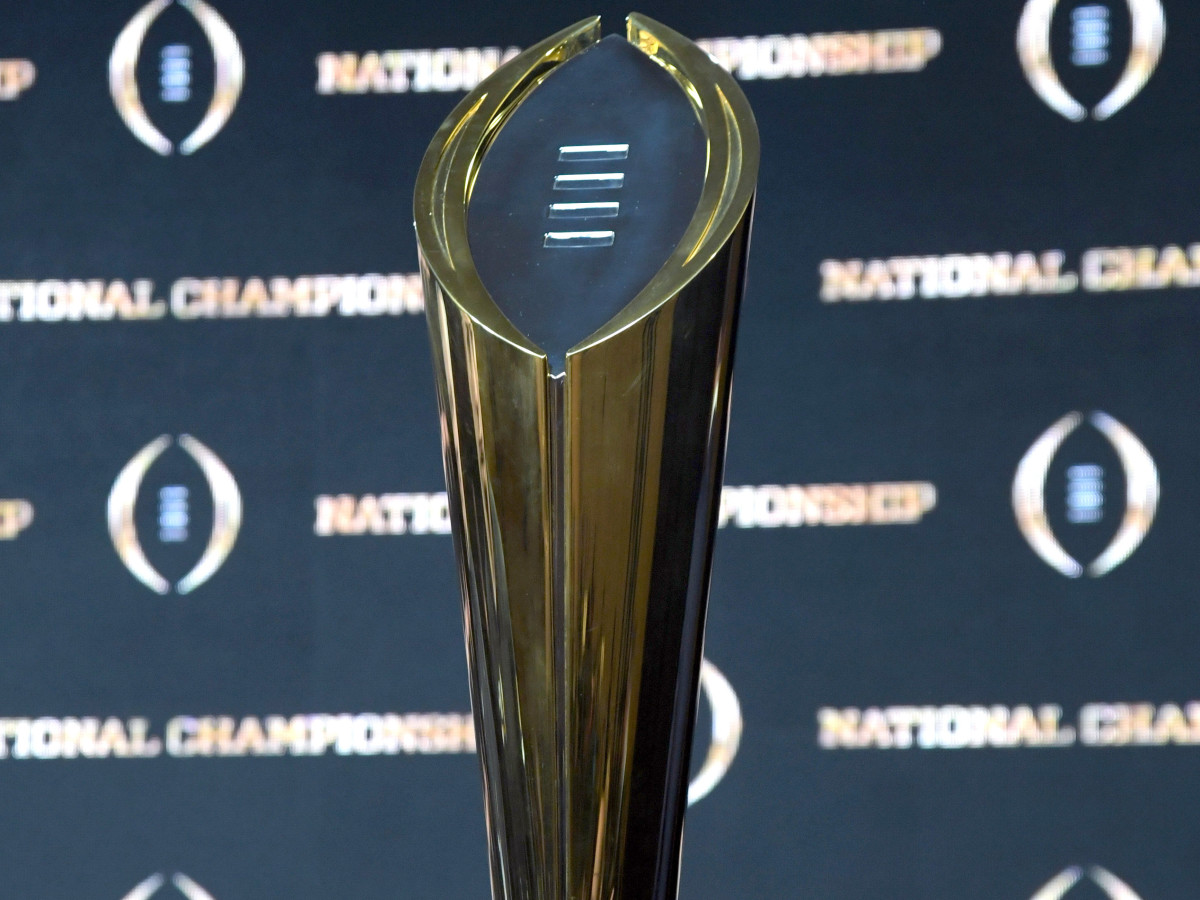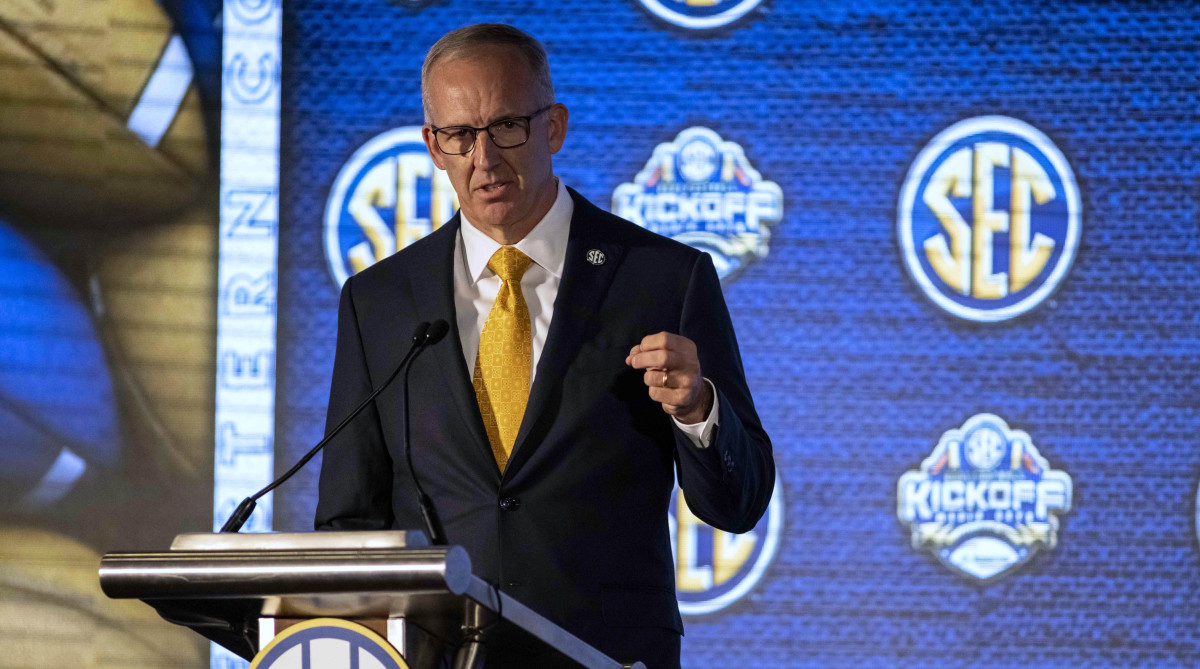Eight or 12? College Football Leaders to Haggle Over Playoff Expansion With $450 Million on the Line
In 1994, a 25-member NCAA committee assigned to explore a College Football Playoff buried the lede.
On page 11 of the committee’s 22-page document revealing its findings, the most important information exists—the postseason formats to be considered.
Option A, the document says, is a one-game championship (something that, as it happens, arrived four years later with the BCS). Option B is a four-team event that the document’s author dubs as a “Final Four tournament.” (Twenty years later, of course, the four-team CFP began.)
Finally, there are options C and D: (C) an eight-team playoff and (D) a 12-team playoff. Each would use a bracket that consists of a combination of automatic qualifiers and at-large berths, and, get this, the 12-teamer would grant first-round byes to the top four teams.
Sound familiar?
“That’s where it all started,” says former UCLA administrator John Sandbrook, a member of that NCAA committee and the author of that 27-year-old report.
Nearly three decades later, college football executives are scheduled to meet next week to examine the same models proposed years ago. The 10 conference commissioners along with Notre Dame athletic director Jack Swarbrick, the decision-makers around playoff expansion, will further explore formats of eight and 12 teams during meetings Wednesday and Thursday in Dallas.

It is the latest and maybe the most important chapter in a somewhat contentious and frustrating saga that’s existed since June, when a subcommittee of conference commissioners announced a 12-team playoff format that at first drew overwhelming praise but has recently faced pushback from their colleagues.
Commissioners enter the meetings having either resolved or have deemed resolvable some of the issues explored in this story from September, including the Rose Bowl, media rights partners and on-campus games. However, more obstacles stand in the way: As many as three league executives, most notably the ACC, prefer an eight-team format.
“What’s holding us up is the eight versus 12,” says one source.
For commissioners to make a change to the current four-team model, all 11 must agree to the new playoff. They are on a time crunch, having about two months to either settle on a new format to be implemented in 2024 or shelve expansion until '26. The CFP’s 12-year contract with ESPN runs through the '25 season but can be amended in its final two years.
Passing on expansion to 12 would be eschewing millions. A 12-team playoff in 2024 and '25 would bring in a combined $450 million in additional television revenue, sources tell Sports Illustrated. An eight-team expansion would not generate any additional revenue because it does not create more inventory.
More: What a 12-Team Playoff Would Look Like After Week 8
Commissioners have scheduled a second window to meet next week, but only if enough progress is made this week.
Confidence in them reaching an agreement next week isn’t high. The more realistic possibility is that they either continue discussions the following week or completely shelve expansion, returning 12–18 months from now to determine a new playoff contract and format that will start in 2026.
“The issue is, are we going to meet again or call it quits?” asks one.
The fight over an eight-team versus a 12-team playoff is expected to take center stage in Dallas.
Proponents say an eight-team model would (1) not extend the regular season as much, important to athlete health and safety; (2) not infringe as much on the academic calendar; (3) give more protection to the historic bowl system; and (4) prevent too many teams from a single conference from gaining access.

However, there exists a deep divide on each of the two eight-team models. Group of 5 commissioners say they will not vote for an eight-team format that does not grant them an automatic berth into the field—a “Best 8,” as it’s known. Meanwhile, several commissioners, including the SEC’s Greg Sankey, are against an eight-team model that provides six automatic qualifiers to conference champions and two at-large spots—a “6+2” format that they believe would leave out worthy schools.
For a majority of commissioners, the compromise is the 12-team proposal that grants six at-large berths and six automatic spots to league champions. It’s why at least one conference commissioner believes the group will eventually settle on 12.
Commissioners made progress in their last meeting in Chicago, described as one of the best and most honest discussions they held.
Those executives concerned about one media rights partner controlling the future of the playoff were put at ease during a media rights presentation. There is a solution for the bowl game issue as well. The Rose Bowl, and any other New Year’s Six bowl that wishes to remain on its traditional date, can be a permanent quarterfinal.
Much has been made of on-campus games in the first round, especially those that might take place in cold-weather environments. There is a solution there, too: Host schools could be given the flexibility to move a game to a regionally located indoor stadium.
Some have concerns over the extra games that a 12-team format could mean for unpaid college athletes. At its max, the 12-team format adds two extra games over the current model (15 to 17 games). But the only way a team reaches that 17-game mark is if it (A) plays in a conference championship game, (B) then plays in a first-round playoff game and (C) then advances to the title game.
“The odds of playing a 17th game are low,” AAC commissioner Mike Aresco has said in the past. “You’d end up playing the same number with an eight-team and no byes.”
One of the biggest drawbacks of a "6+2" model is the teams it would leave out of the field. For instance, if the format were used in 2014, No. 8 Michigan State would have been left out; No. 20 Boise State, the sixth-highest ranked conference champion, would have made the field.
In 2015, eighth-ranked Notre Dame misses the bracket and No. 18 Houston is in. In '19, No. 8 Wisconsin isn’t in, yet No. 17 Memphis is.
And there’s something else, too, says another league leader: “The fact that being at 12 is going to keep about a third of the membership in the race into November. There’s incredible value in that.”
And so, 27 years after one of the first real committees examined a College Football Playoff, leaders are back in a similar position. That year, in 1994, the 25-member committee ultimately recommended an eight-team model.
“We looked at 12,” says Cedric Dempsey, the former NCAA executive director who was on the committee. “And just from a timing standpoint on how long it will take to get through 12 was a concern. Felt like we could handle eight.”
However, the proposal was shot down by the NCAA executive board of presidents. Charles Young, the UCLA chancellor who chaired the playoff committee, was so angry over the decision he stormed out of the board meeting. Back then, opponents of the playoff cited four issues: (1) academic and financial impact on players; (2) how playoff revenue would be distributed; (3) the impact on the bowl system; and, finally, (4) the structure of the playoff.
Some wanted only four teams. Others 12. And then some 16.
Sound familiar?
Years later, Tom Hansen, the former Pac-10 commissioner involved in those 1990s playoff discussions, quips, “Perhaps there is no perfect system.”
Maybe he’s right.
More College Football Coverage:
• What Previous College Football Playoffs Would've Looked Like With 12 Teams
• This Time, Jim Harbaugh Is Having Fun
• Forde-Yard Dash: All Eyes On the Big Ten East in the Playoff Race
